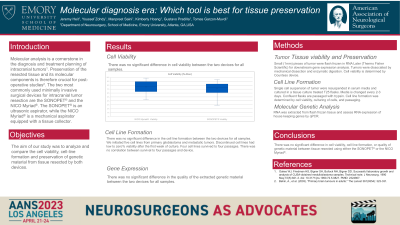Title: Molecular diagnosis era: Which tool is best for tissue preservation
Title: Molecular Diagnosis Era: Which Tool Is Best for Tissue Preservation
Friday, April 21, 2023


Youssef M. Zohdy, MD
Research Fellow
Department of Neurosurgery, Emory University
Alexandria, Egypt
ePoster Presenter(s)
Introduction: With molecular analysis being a cornerstone in the diagnosis and treatment planning of intracranial tumors, preservation of the resected tissue for post-operative studies is crucial. The two most commonly used minimally invasive surgical devices for intracranial tumor resection are the SONOPET® and the NICO Myriad®. The SONOPET® is an ultrasonic aspirator, while the NICO Myriad® is a mechanical aspirator equipped with a tissue collector. Our study aims to identify which device causes less damage to the resected tissue.
Methods: Tissue samples were obtained using both the NICO Myriad® and the SONOPET® systems. Collected tissue was then compared based on cell viability, genetic profiling, protein analysis, and the capability to grow cell lines in malignant gliomas and metastases. Confounding factors were fixed by using both systems in all patients and in same parts of the tumor mass. Additional tumor tissue samples were processed and frozen for further analysis.
Results: Results showed differences in cell viability and cell lines grown from the same tumor samples obtained from both systems. The NICO Myriad® had higher cell viability and enhanced ability for genetic testing compared to the SONOPET®. The analysis pertaining cell line establishment is still underway.
Conclusion : Preservation of resected intracranial tumor tissue, for molecular analysis, is becoming an important aspect in ensuring optimal patients care. Thus, choosing the best resection tool should be based on improving both operative outcomes and post-operative analysis. However, we understand that both resection tools have their limitations.
Methods: Tissue samples were obtained using both the NICO Myriad® and the SONOPET® systems. Collected tissue was then compared based on cell viability, genetic profiling, protein analysis, and the capability to grow cell lines in malignant gliomas and metastases. Confounding factors were fixed by using both systems in all patients and in same parts of the tumor mass. Additional tumor tissue samples were processed and frozen for further analysis.
Results: Results showed differences in cell viability and cell lines grown from the same tumor samples obtained from both systems. The NICO Myriad® had higher cell viability and enhanced ability for genetic testing compared to the SONOPET®. The analysis pertaining cell line establishment is still underway.
Conclusion : Preservation of resected intracranial tumor tissue, for molecular analysis, is becoming an important aspect in ensuring optimal patients care. Thus, choosing the best resection tool should be based on improving both operative outcomes and post-operative analysis. However, we understand that both resection tools have their limitations.
